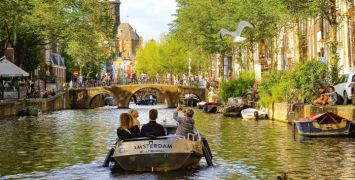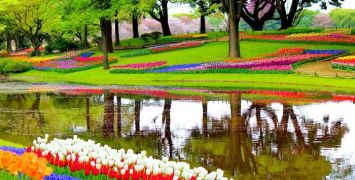Video: Royal Delft Blue Pottery in Holland
Art and craft lovers aboard the hotel barge Panache in Holland wait with baited breath to reach the cruise’s last destination – Delft – the 750-year-old town that gave its name to the elegant blue porcelain that made it world-famous. Our Classic Holland Cruise offers guests the chance to visit the Royal Delft Pottery, as well as an afternoon to explore its charming streets and find out more about its quirks and history.
Delft lies on the Delftsche Schie with the old part of town ringed by canals. In the 17th century, the town’s canal water became tainted, leading to a decline from 200 breweries to 20. In 1654, the “Thunderclap”, an accidental gunpowder explosion leveled half the town and killed hundreds.
But Delft quickly rebounded, thanks to riches the city amassed as the headquarters of the Dutch East India Company. The porcelains brought back by their traders from the Far East proved irresistible, and in 1645, De Porceleyne Fles started making and exporting the blue and-white earthenware that was to make the town famous.
Civil war in China had dried up the source for porcelains, and Delft potters leaped in and created the blue faience that soon became known as Delft Blue. The manufacture of Delft ware, which was world-famed from the 17th to the mid-18th century, has recently been revived. Delft was the birthplace of the scholar and statesman Hugo de Groot, the painter Jan Vermeer, whose “View of Delft” is in the Mauritshuis in The Hague, and the scientist Antoni van Leeuwenhoek who mastered the fledging invention of the microscope.
Related Articles
Why Everyone Should Visit Keukenhof Gardens at Least Once in their Lives!
The world famous Keukenhof Gardens in Holland is renowned for its spring displays of over 7 million colourful tulips and flowering bulbs. Read More
Our 5 Favourite Things to Do in Holland
There's plenty to Holland besides windmills and clogs! Take a look at our 5 favourite experiences that you should try while you're there... Read More
Keukenhof Gardens turn 70!
True, Keukenhof Gardens is beautiful every year, but this year is extra special as it celebrates 70 years of colour and natural beauty! Read More
 English
English
 Spanish
Spanish French
French German
German Norwegian
Norwegian Portuguese
Portuguese Swedish
Swedish Italian
Italian Russian
Russian Simplified Chinese
Simplified Chinese Japanese
Japanese


